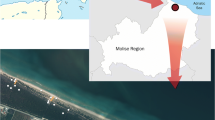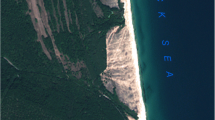Abstract
Trampling is one of the human activities that are harmful for plant species and communities of sand dune ecosystems. The aim of this study was to compare the vegetation of embryonic and shifting Ammophila sand dunes with and without fencing to limit trampling. Fenced sand dunes appeared to be richer in species but differences were more prominent in embryonic sand dunes. Some species (Cakile maritima, Pancratium maritimum) were missing on trampled embryonic dunes. The positive impact of trampling exclusion on embryonic sand dunes was indicated by a lowered slope in a Whittaker graph as well as by rarefaction curves that showed higher species richness on the lower slope. Changes in the vegetation of more stabilised shifting Ammophila sand dunes due to trampling are not evident, although species composition is also impoverished. Fencing of parts of sand dunes proved to be an effective measure for vegetation conservation. In addition to physical exclusion of visitors, fences can also have symbolic value for raising public awareness.


Similar content being viewed by others
References
Acosta A, Carranza ML, Izzi CF (2009) Are there habitats that contribute best to plant species diversity in coastal dunes? Biodivers Conserv 18:1087–1098
Acosta ATR, Jucker T, Prisco I, Santoro R (2013) Passive recovery of Mediterranean coastal dunes following limitations to human trampling. In: Martínez LM, Gallego-Fernández JB, Hesp PA (eds) Restoration of coastal dunes. Springer-Verlag, Berlin Heidelberg, pp. 187–198
Andersen UV (1995) Resistance of Danish coastal vegetation types to human trampling. Biol Conserv 71:223–230. doi:10.1016/0006-3207(94)00031-K
Brown AC, McLachlan A (2002) Sandy shore ecosystems and the threats facing them: some predictions for the year 2025. Environ Conserv 29:62–77. doi:10.1017/S037689290200005X
Brunbjerg AK, Jørgensen GP, Nielsen KM, Pedersen ML, Svenning JC, Ejrnæs R (2015) Disturbance in dry coastal dunes in Denmark promotes diversity of plants and arthropods. Biol Conserv 182:243–253
Burić D, Ducić V, Mihajlović J (2014) The climate of Montenegro: modificators and types, part two. Bull Serbian Geog Soc 9:73–90
Carboni M, Carranza ML, Acosta A (2009) Assessing conservation status on coastal dunes: a multiscale approach. Landsc Urban Plan 91:17–25. doi:10.1016/j.landurbplan.2008.11.004
Ciccarelli D (2014) Mediterranean coastal sand dune vegetation: influence of natural and anthropogenic factors. Environ Manag 54:194–204
Clarke KR (1993) Non-parametric multivariate analysis of changes in community structure. Aust J Ecol 18:117–143
Colwell RK, Chao A, Gotelli NJ, Lin SY, Mao CX, Chazdon RL, Longino JT (2012) Models and estimators linking individual-based and sample-based rarefaction, extrapolation and comparison of assemblages. J Plant Ecol-Uk 5:3–21. doi:10.1093/jpe/rtr044
Davenport J, Davenport JL (2006) The impact of tourism and personal leisure transport on coastal environments: a review estuarine. Coastal Shelf Sci 67:280–292
Defeo O et al (2009) Threats to sandy beach ecosystems: a review. Estuar Coast Shelf Sci 81:1–12. doi:10.1016/j.ecss.2008.09.022
Eckrich TM (2000) Factors affecting the application of green chemistry concepts in pharmaceutical R&D: recent case studies. Abstr Pap Am Chem Soc 220:U427–U427
Fenu G, Cogoni D, Ulian T, Bacchetta G (2013) The impact of human trampling on a threatened coastal Mediterranean plant: the case of Anchusa Littorea Moris (Boraginaceae). Flora 208:104–110. doi:10.1016/j.flora.2013.02.003
Garcia-Mora MR, Gellego-Fernandez JB, Garcia-Novo F (1999) Plant functional types in coastal foredunes in relation to environmental stress and disturbance. J Veg Sci 10:27–34
Glenn-Lewin DC, van der Maarel E (1992) Patterns and processes of vegetation dynamics. In: Glenn-Lewin DC, Peet RK, Veblen TT (eds) Plant succession: theory and prediction. Chapman & Hall, London, pp. 11–59
Gotelli NJ, Colwell RK (2001) Quantifying biodiversity: procedures and pitfalls in the measurement and comparison of species richness. Ecol Lett 4:379–391. doi:10.1046/j.1461-0248.2001.00230.x
Grafals-Soto R, Nordstrom K (2009) Sand fences in the coastal zone: intended and unintended effects. Environ Manag 44:420–429
Hammer Ø, Harper DAT, Ryan PD (2001) PAST: paleontological statistics software package for education and data analysis. Palaeontol Electron 4:1–9
Houston J (2008) Management of Natura 2000 habitats. 2130 *Fixed coastal dunes with herbaceous vegetation ("grey dunes") European Commission
Hsieh TC, Ma KH, Chao A (2013) iNEXT online: interpolation and extrapolation (Version 1.0) http://chao.stat.nthu.edu.tw/blog/software-download/
Hylgaard T, Liddle MJ (1981) The effect of human trampling on a sand dune ecosystem dominated by Empetrum Nigrum. J Appl Ecol 18:559–569
Kerbiriou C, Leviol I, Jiguet F, Julliard R (2008) The impact of human frequentation on coastal vegetation in a biosphere reserve. J Environ Manag 88:715–728
Kutiel P, Eden E, Zhelev Y (2000) Effect of experimental trampling and off-road motorcycle traffic on soil and vegetation of stabilized coastal dunes. Isr Environ Conserv 27:14–23
Labuz T, Grunewald R (2007) Studies on vegetation cover of the Amsterdam youngest dunes of the Swina gate barrier (western polish coast). J Coast Res 23:160–172
Lemauviel S, Rosé F (2003) Response of three plant communities to trampling in a sand dune system in Brittany (France). Environ Manag 31:227–235
Liddle MJ (1975) A selective review of the ecological effects of human trampling on natural ecosystems. Biol Conserv 7:17–36
Magurran A (1988) Measuring biological diversity. Blackwell, Oxford
McLachlan A (2001) Coastal beach ecosystems. In: Lewin R (ed) Encyclopedia of biodiversity. Academic Press, New York, pp. 741–751
McLachlan A, Brown AC (2006) The ecology of sandy shores, 2 edn. Academic Press, New York
Mijović A (1994) The xerohalophytic sand communities of the Long beech Glasnik Instituta za Botaniku i Botaničke Bašte Univerziteta u Beogradu 28:147–157
Mijović A, Popović Z, Karadžić B, Mijatović M, Perišić S (2006) Distribution of xerohalophytic vegetation along the seaward and landward zone in south-Adriatic sandy bach (Montenegro). Biotechnol & Biotechnol Equip 20:30–35
Nordstrom KF, Lampe R, Vandemark LM (2000) Reestablishing naturally functioning dunes on developed coasts. Environ Manag 25:37–51. doi:10.1007/s002679910004
Pescott OL, Stewart GB (2014) Assesing the impact of human trampling on vegetation: a systematic review and meta-analysis of experimental evidence. PeerJ 2:e360. doi:10.7717/peerj.360
Petrović D, Karaman M (2009) Important plant areas in Montenegro – IPA Programme. NVO ZNVO Zeelena Gora, Podgorica
Petrović D, Hadžiablahović S, Vuksanović S, Mačić V, Lakušić D (2012) Katalog tipova staništa Crne Gore značajnih za Evropsku uniju. Podgorica-Beograd-Zagreb
Puijalon S, Piola F, Bornette G (2008) Abiotic stresses increase plant regeneration ability. Evol Ecol 22:493–506
Rickard CA, McLachlan A, Kerley GIH (1994) The effects of vechicular and pedestrian traffic on dune vegetation in South Africa. Ocean Coast Manag 23:225–247
Santoro R, Jucker T, Prisco I, Carboni M, Battisti C, Acosta ATR (2012) Effects of trampling limitation on coastal dune plant communities. Environ Manag 49:534–542. doi:10.1007/s00267-012-9809-6
Scott GAM (1976) The ecology of shingle beach plants. J Ecol 51:517–527
Seer FK, Irmler U, Schrautzer J (2015) Effects of trampling on beach plants at the Baltic Sea. Folia Geobot 50:303–315
Šilc U, Dajić Stevanović Z, Ibraliu A, Luković M, Stešević D (2016a) Human impact on sandy beach vegetation along the southeastern Adriatic coast. Biologia 71:865–874. doi:10.1515/biolog-2016-0111
Šilc U, Mullaj A, Alegro A, Ibraliu A, Dajić Stevanović Z, Luković M, Stešević D (2016b) Sand dune vegetation along the eastern Adriatic coast. Phytocoenologia. doi:10.1127/phyto/2016/0079
StatSoft I (2011) STATISTICA (data analysis software system), version 10.0. www.statsoft.com
Tichý L, Chytrý M (2006) Statistical determination of diagnostic species for site groups of unequal size. J Veg Sci 17:809–818
van der Maarel E (1971) Plant species diversity in relation to management. In: Duffey E, Watt SA (eds) The scientific management of animal and plant communities for conservation. Blackwell, Oxford, pp. 45–64
Walker LR, Wardle DA, Bardgett RD, Clarkson BD (2010) The use of chronosequences in studies of ecological succession and soil development. J Ecol 98:725–736. doi:10.1111/j.1365-2745.2010.01664.x
Whittaker RH (1970) Communities and ecosystems. Macmillian, New York
Acknowledgements
We thank anonymous reviewer for helpful suggestions and comments. Martin Cregeen kindly checked our English. The research was partly financed by Slovenian Research Agency (ARRS) through a research program (P1-0236) and bilateral project (BI-ME/16-17-018).
Author information
Authors and Affiliations
Corresponding author
Rights and permissions
About this article
Cite this article
Šilc, U., Caković, D., Küzmič, F. et al. Trampling impact on vegetation of embryonic and stabilised sand dunes in Montenegro. J Coast Conserv 21, 15–21 (2017). https://doi.org/10.1007/s11852-016-0468-2
Received:
Revised:
Accepted:
Published:
Issue Date:
DOI: https://doi.org/10.1007/s11852-016-0468-2




